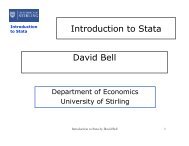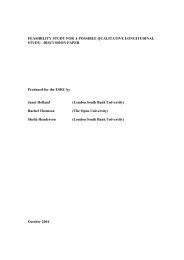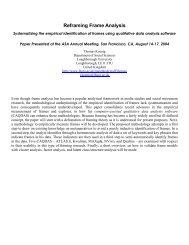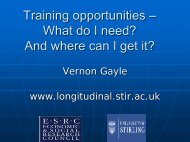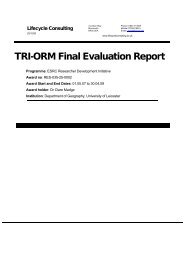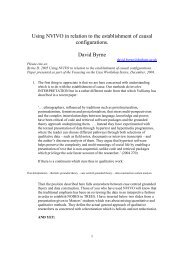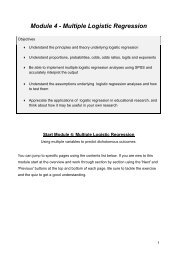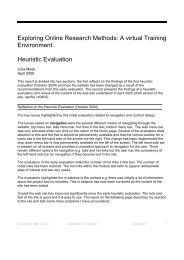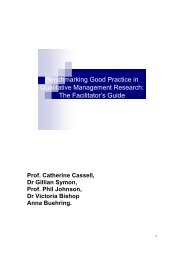benchmarking good practice in qualitative management research1
benchmarking good practice in qualitative management research1
benchmarking good practice in qualitative management research1
You also want an ePaper? Increase the reach of your titles
YUMPU automatically turns print PDFs into web optimized ePapers that Google loves.
BENCHMARKING GOOD PRACTICE IN QUALITATIVE<br />
MANAGEMENT RESEARCH 1<br />
Anna Buehr<strong>in</strong>g, Sheffield Management School<br />
a.buehr<strong>in</strong>g@sheffield.ac.uk<br />
Professor Cather<strong>in</strong>e Cassell, University of Sheffield Management School<br />
c.cassell@sheffield.ac.uk<br />
Dr Phil Johnson, Sheffield Hallam University<br />
p.johnson@shu.ac.uk<br />
Dr Gillian Symon, Birkbeck College, University of London<br />
g.symon@bbk.ac.uk<br />
Introduction<br />
This paper is based upon the f<strong>in</strong>d<strong>in</strong>gs so far of an ESRC funded project <strong>in</strong>vestigat<strong>in</strong>g the use<br />
and evaluation of <strong>qualitative</strong> methods <strong>in</strong> <strong>management</strong> research. Work began <strong>in</strong> March 2003<br />
and is scheduled to run until February 2005. The project is part of a larger programme of<br />
work be<strong>in</strong>g funded by the ESRC, which focuses specifically on extend<strong>in</strong>g and improv<strong>in</strong>g<br />
Research Methods <strong>in</strong> the research and practitioner communities. 2<br />
The project br<strong>in</strong>gs together three grant holders from the <strong>management</strong> field, and a full time<br />
employed research associate. In the short time we have been work<strong>in</strong>g together on the project<br />
we have entered <strong>in</strong>to some <strong>in</strong>terest<strong>in</strong>g debates and philosophical discussions, as well as<br />
encounter<strong>in</strong>g a number of difficult areas where decisions needed to be made, assumptions<br />
challenged and boundaries set. These have <strong>in</strong>cluded: mak<strong>in</strong>g the scope of the project<br />
manageable; def<strong>in</strong><strong>in</strong>g what we (<strong>in</strong> the project team) mean and understand by the term<br />
<strong>qualitative</strong> <strong>management</strong> research; and, def<strong>in</strong><strong>in</strong>g what we mean and understand by the term<br />
<strong>qualitative</strong> methods. We have not arrived at any conclusive or def<strong>in</strong>itive answers, nor do we<br />
necessarily expect to dur<strong>in</strong>g the com<strong>in</strong>g months. What we do know is that the question of<br />
evaluation and assessment of quality <strong>in</strong> <strong>qualitative</strong> <strong>management</strong> research is not a<br />
straightforward area. We are mov<strong>in</strong>g towards some ideas and understand<strong>in</strong>g about the issues<br />
that might <strong>in</strong>fluence the quality of <strong>qualitative</strong> research and where this might lead <strong>in</strong> terms of<br />
the development of more tra<strong>in</strong><strong>in</strong>g, education and dialogue. In this paper, we discuss our work<br />
so far <strong>in</strong> explor<strong>in</strong>g this area and the issues that it raises.<br />
Drivers for the research<br />
Read<strong>in</strong>g many of the ‘prestigious’ journals <strong>in</strong> the <strong>management</strong> discipl<strong>in</strong>e gives the impression<br />
that most research is guided by the hypothetico-deductive approach and is dom<strong>in</strong>ated by<br />
quantitative techniques of analysis. A number of explanations have been put forward for this<br />
situation. Symon and Cassell (1999) identify several barriers to change that are based on<br />
deep-seated yet partial assumptions about what constitutes <strong>good</strong> scientific <strong>practice</strong>. These<br />
tend to underm<strong>in</strong>e the credibility of <strong>qualitative</strong> research. Of particular <strong>in</strong>terest here are the<br />
lack of knowledge and expertise <strong>in</strong> the area and the use of <strong>in</strong>appropriate assessment criteria.<br />
Lack of knowledge and expertise <strong>in</strong> the area<br />
If <strong>management</strong> research and <strong>practice</strong> are to be more <strong>in</strong>novative, equal consideration needs to<br />
be given <strong>in</strong> journals and tra<strong>in</strong><strong>in</strong>g programmes to alternative approaches to analys<strong>in</strong>g,<br />
1 No part of this paper should be re-produced, quoted or cited without the prior permission of the authors.<br />
2 http://www.ccsr.ac.uk/methods/<br />
1
understand<strong>in</strong>g, and <strong>in</strong>terven<strong>in</strong>g <strong>in</strong> organizational life. A cursory view of the methodological<br />
tra<strong>in</strong><strong>in</strong>g provided on University doctoral programmes suggests that there is still a dom<strong>in</strong>ant<br />
focus on quantitative methods that operationalize the hypothetico-deductive framework. The<br />
US Academy of Management has drawn attention to this emphasis, and estimated that there<br />
are five times as many quantitative courses as <strong>qualitative</strong> (Boje, 2001). If <strong>management</strong><br />
researchers are to make the most of the diverse range of <strong>qualitative</strong> methodological tools and<br />
approaches available they need to: be aware of their existence; have knowledge of how to use<br />
them; and be able to evaluate the quality of the research produced, us<strong>in</strong>g assessment criteria<br />
appropriate to the vary<strong>in</strong>g ontological and epistemological commitments encoded <strong>in</strong> the<br />
different methods. One of the aims of this paper is to provide a review of the extent to which<br />
studies based on <strong>qualitative</strong> methods are appear<strong>in</strong>g <strong>in</strong> <strong>management</strong> journals, thus ga<strong>in</strong><strong>in</strong>g<br />
some <strong>in</strong>sight <strong>in</strong>to their current presence with<strong>in</strong> <strong>management</strong> research.<br />
The use of <strong>in</strong>appropriate assessment criteria<br />
An additional barrier to the use and publication of <strong>qualitative</strong> research <strong>in</strong> the <strong>management</strong><br />
sciences is the application of <strong>in</strong>appropriate assessment criteria (Symon et al., 2000). Even<br />
writers who promote <strong>qualitative</strong> research (e.g. Miles and Huberman, 1994; Strauss and<br />
Corb<strong>in</strong>, 1990) may evaluate it <strong>in</strong> terms of the concepts of objectivity, validity and reliability<br />
with little modification (Alvesson and Skoldberg, 2000). These concepts tacitly articulate<br />
positivist metatheoretical assumptions (Johnson and Duberley, 2000; Johnson and Cassell,<br />
2001) which translate <strong>in</strong>to particular evaluative stances on, for example theoretical vs<br />
statistical generalizability (Mitchell, 1983); <strong>in</strong>duction vs deduction (Gill and Johnson, 1997);<br />
ecological vs <strong>in</strong>ternal validity (Bracht and Glass, 1968); reliability and replication (Marshall<br />
and Rossman, 1989); objectivity vs social construction (Burr, 1995); and the role of<br />
reflexivity (Holland, 1999). There is a need for more explicit recognition that different<br />
evaluation criteria need to be used with<strong>in</strong> different metatheoretical approaches (Guba and<br />
L<strong>in</strong>coln, 1989; Johnson and Duberley, 2000).<br />
Therefore, another aim of this work<strong>in</strong>g paper is to set out some of the predom<strong>in</strong>ant arguments<br />
and themes relat<strong>in</strong>g to the evaluation of <strong>qualitative</strong> <strong>management</strong> research, and to question<br />
how these might <strong>in</strong>fluence the judgement of such work <strong>in</strong> the <strong>management</strong> field. In addition,<br />
we speculate on how more appropriate methods of evaluation might be developed and used to<br />
enhance the status, quality and value of <strong>qualitative</strong> <strong>management</strong> research.<br />
Structure of the paper<br />
In the first place, we present a prelim<strong>in</strong>ary review of the literature concern<strong>in</strong>g the<br />
development and use of evaluation criteria. Some of the <strong>in</strong>itial f<strong>in</strong>d<strong>in</strong>gs from the project are<br />
then presented, which identifies <strong>qualitative</strong> methods currently <strong>in</strong> use with<strong>in</strong> a range of<br />
<strong>management</strong> journals. The conclusion draws together some of the ma<strong>in</strong> po<strong>in</strong>ts and strands of<br />
thought evident with<strong>in</strong> the literature, and raises questions about the discrepancies found<br />
with<strong>in</strong> the methods <strong>in</strong> use <strong>in</strong> <strong>management</strong> journals. This will <strong>in</strong>form the further development<br />
of the project and shape the cont<strong>in</strong>u<strong>in</strong>g fieldwork.<br />
Prelim<strong>in</strong>ary review of development and use of evaluation criteria<br />
In review<strong>in</strong>g the literature it appears that there is little clarity <strong>in</strong> relation to evaluat<strong>in</strong>g<br />
<strong>qualitative</strong> research. Present<strong>in</strong>g our work so far it should be acknowledged that one def<strong>in</strong>itive<br />
answer or def<strong>in</strong>ition of evaluation criteria might not be appropriate or possible, and that the<br />
development of such is an ongo<strong>in</strong>g project which can never be static or set <strong>in</strong> stone. Hav<strong>in</strong>g<br />
said that, some of the arguments found with<strong>in</strong> both the <strong>management</strong> literature and social<br />
theory about do<strong>in</strong>g, assess<strong>in</strong>g, or evaluat<strong>in</strong>g, <strong>qualitative</strong> research methods are now presented.<br />
2
Table 1 Def<strong>in</strong>itions/descriptions of <strong>qualitative</strong> research<br />
“Grounded <strong>in</strong> a philosophical position which is broadly ‘<strong>in</strong>terpretivist’ <strong>in</strong> the sense that it is concerned with how the social world is<br />
<strong>in</strong>terpreted, understood, experience or produced. Whilst different versions of <strong>qualitative</strong> research might understand or approach<br />
these elements <strong>in</strong> different ways (for example, focus<strong>in</strong>g on social mean<strong>in</strong>gs, or <strong>in</strong>terpretation, or <strong>practice</strong>s, or discourses, or<br />
processes, or constructions) all will see at least some of these as mean<strong>in</strong>gful elements <strong>in</strong> a complex – possibly multi-layered –<br />
social world.<br />
Based on methods of data generation which are flexible and sensitive to the social context <strong>in</strong> which data are produced (rather than<br />
rigidly standardized or structured, or removed from ‘real life’ or ‘natural’ social context, as <strong>in</strong> some forms of experimental<br />
method).<br />
Based on methods of analysis and explanation build<strong>in</strong>g which <strong>in</strong>volve understand<strong>in</strong>gs of complexity, detail and context.<br />
Qualitative research aims to produce rounded understand<strong>in</strong>gs on the basis or rich, contextual, and detailed data. There is more<br />
emphasis on ‘holistic’ forms of analysis and explanations <strong>in</strong> this sense, than on chart<strong>in</strong>g surface patterns, trends and correlations.<br />
Qualitative research usually does use some form of quantification, but statistical forms of analysis are not seen as central.”<br />
(Mason, 1996, p4)<br />
“Qualitative research is a situated activity that locates the observer <strong>in</strong> the world. It consists of a set of <strong>in</strong>terpretive, material<br />
<strong>practice</strong>s that make the world visible. These <strong>practice</strong>s transform the world. They turn the world <strong>in</strong>to a series of representations,<br />
<strong>in</strong>clud<strong>in</strong>g field notes, <strong>in</strong>terviews, conversations, photographs, record<strong>in</strong>gs, and memos to the self. At this level, <strong>qualitative</strong> research<br />
<strong>in</strong>volves an <strong>in</strong>terpretive, naturalistic approach to the world. This means that <strong>qualitative</strong> researchers study th<strong>in</strong>gs <strong>in</strong> their natural<br />
sett<strong>in</strong>gs, attempt<strong>in</strong>g to make sense of, or to <strong>in</strong>terpret, phenomena <strong>in</strong> terms of mean<strong>in</strong>gs people br<strong>in</strong>g to them.”<br />
(Denz<strong>in</strong> and L<strong>in</strong>coln, 2000, p3)<br />
“<strong>qualitative</strong> is a not-so-descriptive adjective attached to the varieties of social <strong>in</strong>quiry that have their <strong>in</strong>tellectual roots <strong>in</strong><br />
hermeneutics, phenomenological sociology, and the Verstehen tradition. Most scholars use the phrase ‘<strong>qualitative</strong> <strong>in</strong>quiry’ as a<br />
blanket designation for all forms of such <strong>in</strong>quiry <strong>in</strong>clud<strong>in</strong>g ethnography, case study research, naturalistic <strong>in</strong>quiry,<br />
ethnomethodology, life history methodology, narrative <strong>in</strong>quiry, and the like. It has been used as a modifier for the terms “data,”<br />
“method,” “methodology,” “research,” and “paradigm” and as a synonym for “nonexperimental” and “ethnographic.” Because the<br />
adjective does not clearly signal a particular mean<strong>in</strong>g, a great number and variety of scholars have attempted to def<strong>in</strong>e just what is<br />
the so-called <strong>qualitative</strong> paradigm, what are the basic characteristics of <strong>qualitative</strong> research, and so on.”<br />
(Schwandt, 1997, p8)<br />
“Qualitative research has become associated with many different theoretical perspectives, but is typically oriented to the <strong>in</strong>ductive<br />
study of socially constructed reality, focus<strong>in</strong>g on mean<strong>in</strong>gs, ideas and <strong>practice</strong>s, tak<strong>in</strong>g the native’s po<strong>in</strong>t of view seriously without<br />
question<strong>in</strong>g either the wider context of it or the processes form<strong>in</strong>g it.”<br />
(Alvesson and Deetz, 2000, p1)<br />
“Qualitative research seeks to collect the <strong>in</strong>terpretations given by organizational actors to aspects and events of organizational life,<br />
emphasiz<strong>in</strong>g the nuances that emerge from them. Qualitative research usually makes jo<strong>in</strong>t use of participant observation, <strong>in</strong>-depth<br />
<strong>in</strong>terviews and archival <strong>in</strong>formation, more occasionally of only <strong>in</strong>terviews, and much more rarely of observation alone.”<br />
(Bryman, 1989 <strong>in</strong> Strati, 2000, p4)<br />
“The label <strong>qualitative</strong> methods has no precise mean<strong>in</strong>g <strong>in</strong> any of the social sciences. It is at best an umbrella term cover<strong>in</strong>g an array<br />
of <strong>in</strong>terpretive techniques which seek to describe, decode, translate and otherwise come to terms with the mean<strong>in</strong>g, not the<br />
frequency, of certa<strong>in</strong> more or less naturally occurr<strong>in</strong>g phenomena <strong>in</strong> the social world.”<br />
(Van Maanen, 1979, p520)<br />
“In life <strong>in</strong> general, and <strong>in</strong> <strong>qualitative</strong> <strong>in</strong>quiry as a particular k<strong>in</strong>d of research pursuit, we are always engaged <strong>in</strong> try<strong>in</strong>g to “make<br />
someth<strong>in</strong>g of that”; we are always about the bus<strong>in</strong>ess of constru<strong>in</strong>g the mean<strong>in</strong>g of someth<strong>in</strong>g… always try<strong>in</strong>g to understand the<br />
mean<strong>in</strong>gs that actions and utterances have <strong>in</strong> the <strong>in</strong>habited world, the world of everyday life, the world <strong>in</strong> which we go about liv<strong>in</strong>g<br />
our lives.”<br />
(Schwandt, 1999, p452)<br />
Def<strong>in</strong><strong>in</strong>g <strong>qualitative</strong> literature<br />
In order to understand how <strong>qualitative</strong> research is currently ‘judged’ or ‘evaluated’ <strong>in</strong> terms of<br />
quality and how some form of <strong>benchmark<strong>in</strong>g</strong> might be appropriate <strong>in</strong> the future there needs to<br />
3
e some understand<strong>in</strong>g or just what <strong>qualitative</strong> research is. This <strong>in</strong> itself is no mean task and<br />
numerous def<strong>in</strong>itions and assumptions abound. Some examples are provided <strong>in</strong> Table 1. As<br />
Denz<strong>in</strong> and L<strong>in</strong>coln (2000) acknowledge <strong>qualitative</strong> research means different th<strong>in</strong>gs to<br />
different people. Thus, aris<strong>in</strong>g out of these different understand<strong>in</strong>gs, are a multitude of<br />
assumptions, approaches, and criteria, be<strong>in</strong>g applied to make assessments and judgements<br />
about quality. The whole idea of even us<strong>in</strong>g criteria is a contested one. Accord<strong>in</strong>g to<br />
Schwandt (1996, p60) the use and development of criteria is based upon a positivist<br />
epistemology, which “is a systematic and methodical process for acquir<strong>in</strong>g genu<strong>in</strong>e, positivist<br />
scientific knowledge. A preoccupation with method or process as a sure path to genu<strong>in</strong>e<br />
knowledge has come to characterize much of what we def<strong>in</strong>e as legitimate social scientific<br />
<strong>in</strong>vestigation”.<br />
To attempt to f<strong>in</strong>d ‘one best’ def<strong>in</strong>ition of <strong>qualitative</strong> research is perhaps a misguided<br />
endeavour (Cassell and Symon, 1994) and an alternative approach might be to look <strong>in</strong>stead<br />
for def<strong>in</strong><strong>in</strong>g characteristics (Bryman, 1988) of <strong>qualitative</strong> research and how these are applied<br />
<strong>in</strong> specific circumstances.<br />
Evaluat<strong>in</strong>g <strong>qualitative</strong> research<br />
That there is no one s<strong>in</strong>gle def<strong>in</strong>ition or agreed set of pr<strong>in</strong>ciples or guidel<strong>in</strong>es as to what<br />
<strong>qualitative</strong> research is, means that the job of evaluat<strong>in</strong>g or judg<strong>in</strong>g its quality, whether by the<br />
researcher themselves or ‘the researched’, or policy makers/managers or journal editors, is<br />
also fraught with difficulties and contradictions. To attempt to lay out a set of def<strong>in</strong><strong>in</strong>g<br />
criteria is itself a complex issue with<strong>in</strong> the scheme of methodological questions and answers.<br />
So, should the whole project be abandoned as a lost cause? We th<strong>in</strong>k not, as Schwandt (1996,<br />
p59) argues “we must learn to live with uncerta<strong>in</strong>ty, with the absence of f<strong>in</strong>al v<strong>in</strong>dications,<br />
without the hope of solutions <strong>in</strong> the form of epistemological guarantees. Cont<strong>in</strong>gency,<br />
fallibilism, dialogue, and deliberation mark our way of be<strong>in</strong>g <strong>in</strong> the world”. At the same time<br />
this uncerta<strong>in</strong>ty “does not translate <strong>in</strong>to anyth<strong>in</strong>g goes and obviate the necessity of our tak<strong>in</strong>g<br />
a stand on what it is right to do and <strong>good</strong> to be as social <strong>in</strong>quirers”.<br />
Whilst this array of descriptions of <strong>qualitative</strong> research (Table 1) differ <strong>in</strong> their presentation<br />
they do all share a common view of <strong>qualitative</strong> research be<strong>in</strong>g about <strong>in</strong>terpretation flow<strong>in</strong>g<br />
from the Verstehen 3 tradition. However, a largely shared commitment to Verstehen does not<br />
expla<strong>in</strong> the heterogeneity evident <strong>in</strong> what can broadly be classified as <strong>qualitative</strong> <strong>management</strong><br />
research. Nor the way <strong>in</strong> which judgements are made regard<strong>in</strong>g the worth of such material<br />
through the application of <strong>in</strong>appropriate criteria or evaluation. To understand how and why<br />
this might be the case, and what the possible alternatives are, we need to look more closely at<br />
the development and history of evaluation criteria.<br />
Historically, the criteria applied to judg<strong>in</strong>g <strong>qualitative</strong> research have been derived from those<br />
criteria used <strong>in</strong> judg<strong>in</strong>g and evaluat<strong>in</strong>g quantitative research, such as validity, reliability and<br />
generalisability (Reid and Gough, 2000). Such criteria have to some extent been developed<br />
and ref<strong>in</strong>ed by L<strong>in</strong>coln & Guba (1990) cited <strong>in</strong> Reid and Gough (2000) <strong>in</strong>to resonance,<br />
rhetoric, empowerment, and applicability; and then <strong>in</strong>to notions of trustworth<strong>in</strong>ess,<br />
credibility, authenticity, and <strong>good</strong>ness. The notions of validity, rigour, relevance and other<br />
such criteria have come to be so taken for granted <strong>in</strong> much of the tra<strong>in</strong><strong>in</strong>g and literature on<br />
us<strong>in</strong>g research methods that it is sometimes difficult to stand outside this and argue for an<br />
alternative position or set of ideas with<strong>in</strong> which to frame quality evaluation. Accord<strong>in</strong>g to<br />
(Schwandt, 1996, p62) the <strong>in</strong>terpretive tradition of social <strong>in</strong>quiry stills cl<strong>in</strong>gs to “objectivat<strong>in</strong>g<br />
3 “Verstehen: the <strong>in</strong>terpretive understand<strong>in</strong>g of the mean<strong>in</strong>g a set of actions has to an actor through some form of<br />
contact with how they experience their experience” (Johnson, P. and Duberley, J., 2000, p 34)<br />
4
approaches <strong>in</strong> <strong>in</strong>vestigat<strong>in</strong>g lived reality”. In other words the idea that there is a world ‘out<br />
there’ to be discovered and explored <strong>in</strong> an objective and value free way. This dist<strong>in</strong>ction<br />
between social facts and social values is often ma<strong>in</strong>ta<strong>in</strong>ed <strong>in</strong> social research and where values<br />
are judged to have entered the research process render the f<strong>in</strong>d<strong>in</strong>gs void (May, 2001, p60) or<br />
at least less credible.<br />
Who applies the criteria and <strong>in</strong> what context for evaluat<strong>in</strong>g and judg<strong>in</strong>g the quality of research<br />
is a crucial question, because unless we all agree, which we do not, that there can be some<br />
sort of ‘objective’ criteria <strong>in</strong> use across the board, then the application of such is always go<strong>in</strong>g<br />
to be mis-placed. This leads to judgements and decisions that h<strong>in</strong>der rather then assist <strong>in</strong> the<br />
development of better quality and higher standards <strong>in</strong> carry<strong>in</strong>g out <strong>qualitative</strong> research.<br />
With<strong>in</strong> the academic circle of peer review this process can lead to gatekeep<strong>in</strong>g powers be<strong>in</strong>g<br />
exerted and lead us to question, “how we come to value some reports above others” (Reid and<br />
Gough, 2000, p64). The def<strong>in</strong>ition and application of criteria stems not only from the<br />
def<strong>in</strong>itions of <strong>good</strong> quantitative research but rest upon those assumptions explicit with<strong>in</strong><br />
positivist and post-positivist approaches to ‘validity’. The question of validity arises out of a<br />
search for ‘test<strong>in</strong>g’ and ‘truth values’ which “has underp<strong>in</strong>ned conventional social science as a<br />
criteria for measur<strong>in</strong>g the worth of research” (Scheurich, 1997, p81). The implications of<br />
mak<strong>in</strong>g such ‘validity’ judgements are, accord<strong>in</strong>g to Scheurich, that boundaries are<br />
established which, seek to “exclude that which questions or attacks the paradigmatic status<br />
quo as well as views outside the understand<strong>in</strong>g available to that status quo. In other words,<br />
validity boundaries are always already ideological power alignments. They always create<br />
<strong>in</strong>siders and outsiders” (Ibid., p84). Such criteria and the values associated with them are <strong>in</strong><br />
everyday use (Scandura and Williams, 2000; Cooper, 2001) and reflected <strong>in</strong> editorial policy<br />
statements for certa<strong>in</strong> <strong>management</strong> journals (Lee, 2001).<br />
The literature review so far is po<strong>in</strong>t<strong>in</strong>g towards an array of different evaluation possibilities<br />
which might be applied <strong>in</strong> a complex world where <strong>qualitative</strong> research might not provide the<br />
‘solutions’ or ‘answers’ to problems historically associated with <strong>management</strong> research, and<br />
stemm<strong>in</strong>g from more traditional ‘social scientific’ beliefs and assumptions. In order to ga<strong>in</strong><br />
greater <strong>in</strong>sight <strong>in</strong>to current approaches and methods of <strong>qualitative</strong> <strong>management</strong> research <strong>in</strong><br />
use a review of some of the <strong>management</strong> journals was undertaken. This is by no means a full<br />
and comprehensive review of all <strong>management</strong> journals or all discipl<strong>in</strong>es with<strong>in</strong> the<br />
<strong>management</strong> doma<strong>in</strong>, which would have been impossible with<strong>in</strong> the scope of the project.<br />
Some of the difficulties and decisions upon which the review is based are elaborated upon<br />
below, and to some extent highlight aga<strong>in</strong> the complexity and diverse nature of <strong>management</strong><br />
research and how this might need to be considered <strong>in</strong> the context of the quality debate.<br />
Methods-<strong>in</strong>-use<br />
The ma<strong>in</strong> aim of this part of the research is to identify <strong>qualitative</strong> research methods <strong>in</strong> use<br />
with<strong>in</strong> the <strong>management</strong> field and the methodological perspectives <strong>in</strong>form<strong>in</strong>g the use of<br />
<strong>qualitative</strong> methods, <strong>in</strong> order to ga<strong>in</strong> a better <strong>in</strong>sight <strong>in</strong>to what is be<strong>in</strong>g published and where.<br />
This <strong>in</strong> turn will be used to help develop the research project further <strong>in</strong> terms of the questions<br />
to be posed with selected <strong>in</strong>terviewees (journal editors, research commissioners, doctoral<br />
programme academics, bus<strong>in</strong>ess researchers and academic researchers us<strong>in</strong>g <strong>qualitative</strong><br />
methods). Initial scop<strong>in</strong>g of the review highlighted a number of problems, which required<br />
decisions with<strong>in</strong> the project team to create boundaries and make explicit the approach, and<br />
methods used.<br />
Scope and search parameters<br />
Firstly, the multi-discipl<strong>in</strong>ary nature of <strong>management</strong> research was an issue. How should we<br />
decide which journals to <strong>in</strong>clude or exclude <strong>in</strong> the search? This decision has evolved dur<strong>in</strong>g<br />
5
the course of the project and was based upon: the highest impact scor<strong>in</strong>g of journals accord<strong>in</strong>g<br />
to the ISI Citation Reports; discussion and agreement <strong>in</strong> the project group of the most relevant<br />
and useful journals for this exercise; the need to focus on journals that are specifically<br />
“<strong>management</strong>” rather than specialis<strong>in</strong>g <strong>in</strong> any particular <strong>in</strong>terest/discipl<strong>in</strong>e. i<br />
Second, which search terms should we use and how would these <strong>in</strong>fluence what we might<br />
f<strong>in</strong>d <strong>in</strong> terms of <strong>qualitative</strong> methods? Several different words were used with<strong>in</strong> the <strong>in</strong>itial<br />
scop<strong>in</strong>g searches, which threw up an unmanageable number of articles, which it appeared did<br />
not necessarily utilise <strong>qualitative</strong> research methods. The f<strong>in</strong>al list of search terms ii for the<br />
first searches to identify methods <strong>in</strong> use was based upon the most common methods that could<br />
imply the conduct of <strong>qualitative</strong> research. The first set of searches carried out comb<strong>in</strong>ed the<br />
keywords with ‘<strong>management</strong>’ <strong>in</strong> the journal title, but was not conf<strong>in</strong>ed to the specified<br />
journals listed <strong>in</strong> note (i).<br />
Thirdly, <strong>in</strong> order to identify some more of the perspectives and ga<strong>in</strong> greater <strong>in</strong> depth<br />
understand<strong>in</strong>g of the methods <strong>in</strong> use a further search was carried out with<strong>in</strong> the named<br />
specified journals <strong>in</strong> note (i) us<strong>in</strong>g the search terms encompass<strong>in</strong>g a wider range of research<br />
approaches believed to be associated with <strong>qualitative</strong> research iii . One s<strong>in</strong>gle database<br />
(EBSCO Bus<strong>in</strong>ess Source Premier) was used to search, and method/methodology/analysis<br />
extracts from the journal articles reviewed.<br />
Keyword search <strong>in</strong> BIDS and Emerald<br />
January 1995 to March 2003<br />
n = 367<br />
Number of articles found<br />
80<br />
70<br />
60<br />
50<br />
40<br />
30<br />
20<br />
10<br />
0<br />
1995 1996 1997 1998 1999 2000 2001 2002 2003<br />
Figure 1 Trends <strong>in</strong> the number of articles found us<strong>in</strong>g <strong>qualitative</strong> methods criteria<br />
Search results<br />
The f<strong>in</strong>d<strong>in</strong>gs presented here were undertaken at the start of the project. Further work is still<br />
be<strong>in</strong>g carried out reflect<strong>in</strong>g upon the f<strong>in</strong>d<strong>in</strong>gs so far and what we will learn dur<strong>in</strong>g the<br />
cont<strong>in</strong>u<strong>in</strong>g research process.<br />
The search from 1995 to 2000 revealed a steady upward trend <strong>in</strong> the number of articles<br />
identified us<strong>in</strong>g the <strong>qualitative</strong> methods search terms (Figure 1). Whilst this does not<br />
substantiate an <strong>in</strong>crease <strong>in</strong> the use of <strong>qualitative</strong> methods itself - the rise may also be due to an<br />
<strong>in</strong>creased number of published articles <strong>in</strong> general, or to changes <strong>in</strong> publisher/editorial board<br />
considerations - it does <strong>in</strong>dicate a possible steady rise <strong>in</strong> their popular use. This historical<br />
6
search was conf<strong>in</strong>ed to review<strong>in</strong>g the abstracts only, and therefore may conta<strong>in</strong> some<br />
anomalies <strong>in</strong> the number and type of <strong>qualitative</strong> methods found. However, for the purpose of<br />
this literature review it was felt adequate <strong>in</strong> identify<strong>in</strong>g a possible change <strong>in</strong> the use of<br />
<strong>qualitative</strong> methods, and the types of methods <strong>in</strong> use.<br />
Method types from BIDS and Emerald 1995 to 2003<br />
n = 367<br />
Diaries<br />
Biography 1%<br />
Critical Incident<br />
4%<br />
Technique<br />
7%<br />
Ethnography<br />
23%<br />
Action Research<br />
28%<br />
Participant<br />
6%<br />
Storytell<strong>in</strong>g<br />
11%<br />
Focus Group<br />
20%<br />
Figure 2 Types of <strong>qualitative</strong> methods identified 1995 to 2003<br />
Journal Name<br />
1995 1996 1997 1998 1999 2000 2001 2002 2003 Totals<br />
Academy of Management Journal 2 0 0 0 1 3 1 3 0 10<br />
Adm<strong>in</strong>istrative Science Quarterly 0 3 4 3 2 1 0 1 0 14<br />
British Journal of Management 0 1 3 0 1 3 2 1 0 11<br />
California Management Review 0 0 0 0 0 0 1 0 0 1<br />
Harvard Bus<strong>in</strong>ess Review 0 0 1 0 0 0 1 0 0 2<br />
International Journal of Management Reviews 0 0 0 0 0 0 1 0 0 1<br />
Journal of Management 0 0 0 0 0 0 0 0 0 0<br />
Journal of Management Inquiry 0 0 0 0 1 1 1 4 0 7<br />
Journal of Management Studies 2 0 1 2 2 2 2 1 2 14<br />
Management Communication Quarterly 0 0 0 0 0 2 1 1 0 4<br />
Management Learn<strong>in</strong>g 0 1 1 0 6 1 2 4 1 16<br />
Management Science 0 0 0 0 0 0 0 0 0 0<br />
MIT Sloan Management Review 0 0 0 0 0 0 0 1 0 1<br />
Omega 0 0 0 0 0 1 0 2 1 4<br />
Organizational Research Methods 0 0 0 0 0 0 1 0 0 1<br />
Scand<strong>in</strong>avian Journal of Management 0 0 1 0 0 0 0 0 0 1<br />
Sloan Management Review 0 0 0 0 0 0 0 0 0 0<br />
Strategic Management Journal 0 0 0 0 0 0 1 0 0 1<br />
All others 15 28 23 28 32 40 59 48 10 283<br />
Total 19 33 34 33 45 54 73 66 14 371<br />
Table 2 Number of articles found between 1995 and 2003<br />
The percentage of different methods identified can be seen <strong>in</strong> Figure 2. This aga<strong>in</strong> can only<br />
be taken as a broad <strong>in</strong>dication of the types of methods <strong>in</strong> use, because of the difficulty <strong>in</strong><br />
identify<strong>in</strong>g details of the studies from the abstracts.<br />
Table 2 shows the number of articles found across each of the journals, highlight<strong>in</strong>g a split<br />
between some of the UK and US based journals. The search found a number of articles <strong>in</strong> the<br />
follow<strong>in</strong>g journals: California Management Review; Harvard Bus<strong>in</strong>ess Review; Journal of<br />
Management; Management Science; MIT Sloan Management Review; Organizational<br />
Research Methods; Sloan Management Review; Strategic Management Journal which, on<br />
closer scrut<strong>in</strong>y were found not to be based on empirical research or were theoretical<br />
discussions about the merits or otherwise of us<strong>in</strong>g <strong>qualitative</strong> methods. These were excluded<br />
7
from this analysis because of the focus of this research on use of <strong>qualitative</strong> methods <strong>in</strong><br />
<strong>practice</strong>.<br />
Number of articles found <strong>in</strong> selected journals us<strong>in</strong>g <strong>qualitative</strong> methods<br />
Jan2000 to M arch 2003<br />
n = 79<br />
25<br />
20<br />
15<br />
10<br />
5<br />
0<br />
Figure 3 Number of articles found <strong>in</strong> selected journals<br />
A further search was designed to look <strong>in</strong> more depth at the different methods and perspectives<br />
<strong>in</strong> use with<strong>in</strong> <strong>qualitative</strong> <strong>management</strong> research. The number of articles found appears <strong>in</strong><br />
Figure 3. As far as possible the type of methods and perspectives were identified, where these<br />
were made explicit, as well as any underly<strong>in</strong>g theoretical approaches. The full text articles <strong>in</strong><br />
most journals were reviewed and <strong>in</strong> particular the paragraphs on methods and analysis. At the<br />
same time observations and notes were made about some of the characteristics, content and<br />
style of the journals and journal articles, and these will be reported later. Figure 3 highlights<br />
the disparity between the American journals and British journals, as well as the low numbers<br />
of articles found overall.<br />
The types of methods found (Figure 4) were categorised as far as possible us<strong>in</strong>g the explicit<br />
statements <strong>in</strong> the text of the journal articles. However, <strong>in</strong> some cases reference was made to<br />
more than one method or one method seemed to take a more prom<strong>in</strong>ent role <strong>in</strong> the research.<br />
In these cases a judgement was made to record the one that seemed to represent the overall<br />
approach taken <strong>in</strong> the research i.e. ethnography where a comb<strong>in</strong>ation of <strong>in</strong>terviews,<br />
observations, and document analysis were used over a period of time. Clearly a wide range of<br />
methods have been found, however bear<strong>in</strong>g <strong>in</strong> m<strong>in</strong>d the relatively small number of cases,<br />
some of these i.e. focus groups equate to only one record.<br />
8
Types of <strong>qualitative</strong> methods found <strong>in</strong> selected journals<br />
Jan 2000 to M arch 2003<br />
n = 79<br />
Obser vat ion<br />
3%<br />
Narrat ive<br />
10%<br />
Mixed met hod<br />
3%<br />
St oryt ell<strong>in</strong>g<br />
5%<br />
Act ion research Biography<br />
11%<br />
1%<br />
Case st udy<br />
3%<br />
Conversat ion analysis<br />
5%<br />
Discourse analysis<br />
6%<br />
Int erviews<br />
29%<br />
Focus/ discussion group<br />
1%<br />
Document analysis<br />
10%<br />
Et hnography<br />
13%<br />
Figure 4 Types of methods found <strong>in</strong> detailed search<br />
A number of perspectives were identified and made explicit <strong>in</strong> the articles found however, it<br />
was often difficult to identify what these were or they were referred to <strong>in</strong> a cursory fashion.<br />
Where a research perspective was mentioned, even though little explanation or elaboration<br />
was made about it, it has been <strong>in</strong>cluded. For example, many articles did refer to social<br />
constructionism or constructivism with no more than a cited reference. This has been noted<br />
by other authors such as Czarniawska (2001, p254) who says “Many <strong>in</strong>terpretively m<strong>in</strong>ded<br />
theorists simply reiterate, follow<strong>in</strong>g Berger and Luckmann (1966), that ‘reality is socially<br />
constructed’”.<br />
Comment: f<strong>in</strong>d article and put<br />
<strong>in</strong>to endnote<br />
Instances of research perspectives <strong>in</strong> selected journals Jan 2000 to March 2003<br />
Number of <strong>in</strong>stances<br />
18<br />
16<br />
14<br />
12<br />
10<br />
8<br />
6<br />
4<br />
2<br />
0<br />
Critical Theory<br />
Discourse analysis<br />
Ethnomethodology<br />
Fem<strong>in</strong>ist theory<br />
Grounded theory<br />
Interpretivist<br />
Phenomenology<br />
Postmodernist<br />
Sensemak<strong>in</strong>g<br />
Social constructionism<br />
Figure 5 Types of research perspectives and methodological approaches<br />
The number and type of perspectives and methodological approaches are shown <strong>in</strong> Figure 5.<br />
Where for example an article talked about us<strong>in</strong>g a social constructionist perspective with<br />
fem<strong>in</strong>ist theory then both have been recorded. Further work on this aspect of the review is<br />
be<strong>in</strong>g carried out and will be forthcom<strong>in</strong>g.<br />
9
The follow<strong>in</strong>g po<strong>in</strong>ts were noted while review<strong>in</strong>g the full text articles:<br />
• Whilst some articles were explicit and open about the choice and applicability of methods<br />
used <strong>in</strong> relation to the research question, <strong>in</strong> others it was difficult to f<strong>in</strong>d the methodology<br />
and rationale beh<strong>in</strong>d the empirical work and methods used. In some cases where<br />
methodology and research perspectives were made explicit they seemed to show a<br />
conflict<strong>in</strong>g epistemological position with the methods used. For example, one article<br />
stated that she had drawn from critical theory and social constructionist perspectives, but<br />
then went on to use quantitative methods for hypothesis test<strong>in</strong>g.<br />
• There was a tendency ma<strong>in</strong>ly <strong>in</strong> the American journals, to write about the use of<br />
<strong>qualitative</strong> research almost <strong>in</strong> an apologetic manner, i.e. that it does not conform to<br />
quantitative criteria of validity, generalization, and bias. Data analysis was often carried<br />
out us<strong>in</strong>g some sort of cod<strong>in</strong>g method, but without any reference to ‘<strong>in</strong>terpretation’ of the<br />
f<strong>in</strong>d<strong>in</strong>gs. The coded text was then translated <strong>in</strong>to numerical data and presented<br />
statistically. For example, “Like all methods, our approach has limitations. While<br />
allow<strong>in</strong>g us to delve deeply <strong>in</strong>to the <strong>in</strong>teractions between the decision-mak<strong>in</strong>g process and<br />
the surround<strong>in</strong>g context, our ethnographic approach limits the generalizability of our<br />
f<strong>in</strong>d<strong>in</strong>gs. However, the utility of our approach lies not <strong>in</strong> the direct transferability of our<br />
f<strong>in</strong>d<strong>in</strong>gs, but <strong>in</strong> the ability to produce grounded theory that could not be identified with a<br />
broader-brush data collection method. Further, by us<strong>in</strong>g causal loop diagrams to specify<br />
our emerg<strong>in</strong>g theory, we have made it easier for scholars to mathematically formalize and<br />
empirically test our results” (Perlow et al., p934)<br />
• A number of prom<strong>in</strong>ent authors were repeatedly cited <strong>in</strong> many of the articles. Some of<br />
these have been recorded and are presented <strong>in</strong> Table 3. This might be significant <strong>in</strong><br />
develop<strong>in</strong>g <strong>in</strong>terview questions regard<strong>in</strong>g evaluation decisions based upon certa<strong>in</strong><br />
assumptions or ways of th<strong>in</strong>k<strong>in</strong>g that are represented <strong>in</strong> these texts. (Kle<strong>in</strong> and Myers,<br />
1999) identify Y<strong>in</strong> (1994) and Benbasat et al (1987) as examples of <strong>management</strong><br />
researchers carry<strong>in</strong>g out <strong>qualitative</strong> research from a positivist perspective, carry<strong>in</strong>g with it<br />
the underly<strong>in</strong>g philosophical assumptions of this perspective. Scheurich (1997) also cites<br />
Miles and Huberman (1984) and L<strong>in</strong>coln and Guba (1985) as examples of post-positivists<br />
who reta<strong>in</strong> their allegiance to validity criteria despite discard<strong>in</strong>g conventional science.<br />
Berger &<br />
Luckmann<br />
Denz<strong>in</strong><br />
Glaser &<br />
Strauss<br />
Miles &<br />
Huberman<br />
Pettigrew<br />
Weick<br />
Y<strong>in</strong><br />
Total<br />
number Total<br />
of number<br />
<strong>in</strong>stances of articles<br />
cited found<br />
Academy of Management Journal 1 1 2 2 2 3 2 13 6<br />
Adm<strong>in</strong>istrative Science Quarterly 1 1 1 1 4 2<br />
Omega (Oxford) 2 1 4 7 4<br />
Scand<strong>in</strong>avian Journal of Management 1 1 1 2 5 3<br />
Journal of Management Studies 5 1 7 2 6 13 1 35 22<br />
British Journal of Management 2 3 3 4 7 1 20 15<br />
Journal of Management Inquiry 1 2 2 5 4<br />
Management Learn<strong>in</strong>g 1 3 4 10<br />
Table 3 Frequently cited authors<br />
Summary<br />
The f<strong>in</strong>d<strong>in</strong>gs presented here are the beg<strong>in</strong>n<strong>in</strong>gs of an analysis of what is go<strong>in</strong>g on out there <strong>in</strong><br />
the world of <strong>qualitative</strong> research and publication. There are <strong>in</strong>dications that differences exist<br />
10
etween and with<strong>in</strong> the US/UK/ journals identified with<strong>in</strong> this study 4 . These are apparent <strong>in</strong><br />
the numbers and types of articles identified here with<strong>in</strong> particular journals, and might be<br />
expla<strong>in</strong>ed partly <strong>in</strong> terms of the underly<strong>in</strong>g epistemological and ontological assumptions<br />
be<strong>in</strong>g made by the ‘gatekeepers’ of academic journals.<br />
Questions aris<strong>in</strong>g from this review so far lead us to ask, is it that <strong>qualitative</strong> <strong>management</strong><br />
research is not be<strong>in</strong>g carried out (or at least to the same extent as quantitative <strong>management</strong><br />
research is)? Or, is it be<strong>in</strong>g done but not be<strong>in</strong>g reported <strong>in</strong> the most prom<strong>in</strong>ent <strong>management</strong><br />
journals, despite editorials welcom<strong>in</strong>g its contribution?<br />
These questions are now developed <strong>in</strong> the conclud<strong>in</strong>g part of this paper.<br />
Conclusion<br />
By study<strong>in</strong>g the use and evaluation of <strong>qualitative</strong> methods it is not the <strong>in</strong>tention to de-value<br />
quantitative research methods or to promote <strong>qualitative</strong> ones as somehow superior. They<br />
exist <strong>in</strong> relation to one another and <strong>in</strong> effect def<strong>in</strong>e each other as “nonnumeric data <strong>in</strong> the form<br />
of words” and “numeric data” (Schwandt, 1997, p130). Such a simple and straightforward<br />
dist<strong>in</strong>ction is helpful <strong>in</strong> a technical sense but is not satisfactory if you adhere to the<br />
epistemological view that, “quantitative and <strong>qualitative</strong> research are located <strong>in</strong> different ways<br />
of know<strong>in</strong>g” and as such methods are not ‘neutral devices’ to use to go and discover the world<br />
out there, but are loaded with assumptions and presuppositions (Bryman, 1998, p139).<br />
We have started to highlight some of the seem<strong>in</strong>gly contradictory applications of methods <strong>in</strong><br />
use with different epistemological perspectives <strong>in</strong> the journal articles found. Whilst it may be<br />
possible to hold a positivist or neo-empiricist approach and use <strong>qualitative</strong> methods, these<br />
perspectives are rarely made explicit with<strong>in</strong> the research lead<strong>in</strong>g to <strong>in</strong>consistencies <strong>in</strong><br />
understand<strong>in</strong>g how this <strong>in</strong>forms the method, empirical study, analysis of data and application<br />
of quality assessment criteria. Further <strong>in</strong>vestigation is underway with<strong>in</strong> the project to explore<br />
some of these issues <strong>in</strong> greater depth.<br />
Because of the variety of forms of <strong>qualitative</strong> research evident <strong>in</strong> the <strong>management</strong> literature,<br />
provid<strong>in</strong>g criteria for its evaluation becomes a problematic process because ‘quality’ becomes<br />
polysemous, and therefore a somewhat elusive, concept. This plurality may be, <strong>in</strong> part, an<br />
outcome of the diverse discipl<strong>in</strong>ary roots at play <strong>in</strong> <strong>management</strong> research. However, it is also<br />
evident that a significant <strong>in</strong>fluence upon how <strong>qualitative</strong> research is variably constituted, and,<br />
<strong>in</strong> pr<strong>in</strong>ciple, should be differentially evaluated, lies <strong>in</strong> how <strong>qualitative</strong> researchers may<br />
articulate diverse metatheoretical commitments. While it is important that methodological<br />
issues <strong>in</strong> <strong>qualitative</strong> research should be transparent and hence open to critical scrut<strong>in</strong>y, a<br />
degree of confusion may arise especially when evaluative criteria constituted by particular<br />
metatheoretical commitments are universally applied to what is a heterogeneous field <strong>in</strong>spired<br />
by a number of <strong>in</strong>commensurable epistemological and ontological dispositions.<br />
In order to further understand<strong>in</strong>g of these issues, we have started to develop a metatheoretical<br />
analysis of evaluation. This entails specification of the overarch<strong>in</strong>g structures of thought<br />
with<strong>in</strong> a substantive doma<strong>in</strong> so as to <strong>in</strong>dicate the conditions under which particular<br />
perspectives are deemed appropriate. Such a metatheoretical exam<strong>in</strong>ation can serve as a<br />
heuristic device enabl<strong>in</strong>g us to describe and expla<strong>in</strong> the cont<strong>in</strong>gent nature of criteriology <strong>in</strong><br />
<strong>management</strong> research and foster some consistency between a priori knowledge constitut<strong>in</strong>g<br />
assumptions, methodology and evaluation.<br />
4 We acknowledge that we have excluded many other <strong>management</strong> journals from specific <strong>management</strong><br />
discipl<strong>in</strong>es that might also actively encourage the publication of <strong>qualitative</strong> research. However, our concerns<br />
were to look at the most prom<strong>in</strong>ent non-specific journals as expla<strong>in</strong>ed earlier <strong>in</strong> the text.<br />
11
Bibliography<br />
Alvesson, M. and Deetz, S. (2000) Do<strong>in</strong>g critical <strong>management</strong> research, Sage, London.<br />
Alvesson, M. and Skoldberg, K. (2000) Reflexive methodology: new vistas for <strong>qualitative</strong><br />
research, Sage, London.<br />
Benbasat, I., Goldste<strong>in</strong>, D. K. and Mead, M. (1987) The case research strategy <strong>in</strong> studies of<br />
<strong>in</strong>formation systems, MIS Quarterly, 11, 3, pp. 369-386<br />
Berger, P. and Luckmann, T. (1966/1971) The social construction of reality, Pengu<strong>in</strong>,<br />
Harmondsworth.<br />
Boje, D. (2001) Report from the Division Chair, Academy of Management Research Methods<br />
Division Newsletter, 16, 2, pp.<br />
Bracht, G. H. and Glass, G. U. (1968) The external validity of experiments, American<br />
Educational Research Journal, 5, 5, pp. 537-574<br />
Bryman, A. (1988) Quantity and quality <strong>in</strong> social research, Unw<strong>in</strong> Hyman, London.<br />
Bryman, A. (1989) Research methods and organization studies, Unw<strong>in</strong> Hyman, London.<br />
Bryman, A. (1998) Quantitative and <strong>qualitative</strong> research strategies <strong>in</strong> know<strong>in</strong>g the social<br />
world. In: May, T. and Williams, M. (ed.) Know<strong>in</strong>g the social world, Open University Press,<br />
Buck<strong>in</strong>gham.<br />
Burr, V. (1995) Introduction to social construction, Routledge, London.<br />
Cassell, C. M. and Symon, G. (1994) Qualitative methods <strong>in</strong> organizational research. A<br />
practical guide., Sage, London.<br />
Cooper, C. D. (2001) Not just a numbers th<strong>in</strong>g: Tactics for improv<strong>in</strong>g reliability and validity<br />
<strong>in</strong> <strong>qualitative</strong> research, http://www.aom.pace.edu/rmd/2001forum.html<br />
Czarniawska, B. (2001) Is it possible to be a constructionist consultant?, Management<br />
Learn<strong>in</strong>g, 32, 2, pp. 253-266<br />
Denz<strong>in</strong>, N. K. and L<strong>in</strong>coln, Y. S. (eds.) (2000) Handbook of <strong>qualitative</strong> research, 2nd, Sage,<br />
Thousand Oaks.<br />
Gill, J. and Johnson, P. D. (1997) Research methods for managers, Sage, London.<br />
Guba, E. and L<strong>in</strong>coln, Y. (1989) Fourth generation evaluation, Sage: Newbury Park.<br />
Holland, R. (1999) Reflexivity, Human Relations, 52, 4, pp. 463-483<br />
Johnson, P. and Cassell, C. (2001) Epistemology and work psychology: new agendas, Journal<br />
of Occupational and Organizational Psychology, 74, 125-143<br />
Johnson, P. and Duberley, J. (2000) Understand<strong>in</strong>g <strong>management</strong> research: An <strong>in</strong>troduction to<br />
epistemology, Sage, London.<br />
Kle<strong>in</strong>, H. K. and Myers, M. D. (1999) A set of pr<strong>in</strong>ciples for conduct<strong>in</strong>g and evaluat<strong>in</strong>g<br />
<strong>in</strong>terpretive field studies <strong>in</strong> <strong>in</strong>formation systems, MIS Quarterly, 23, 1, pp. 67-94<br />
Lee, T. (2001) On Qualitative Research <strong>in</strong> AMJ, Academy of Management Journal, 44, 2, pp.<br />
215-216<br />
L<strong>in</strong>coln, Y. and Guba, E. (1990) Judg<strong>in</strong>g the quality of case study reports, International<br />
Journal of Qualitative Studies <strong>in</strong> Education, 20, 2, pp. 3-5<br />
L<strong>in</strong>coln, Y. S. and Guba, E. G. (1985) Naturalistic <strong>in</strong>quiry, Sage, CA.<br />
12
Marshall, C. and Rossman, G. (1989) Design<strong>in</strong>g Qualitative Research, Sage, CA.<br />
Mason, J. (1996) Qualitative research<strong>in</strong>g, Sage, London.<br />
May, T. (2001) Social research. Issues, methods and process, Open University Press,<br />
Buck<strong>in</strong>gham.<br />
Miles, M. B. and Huberman, A. M. (1984) Qualitative data analysis: a sourcebook of new<br />
methods, Sage, Beverly Hills.<br />
Miles, M. B. and Huberman, A. M. (1994) Qualitative data analysis: a source book of new<br />
methods, Sage, London.<br />
Mitchell, J. C. (1983) Case and Situational Analysis, Sociological Review, 31, 187-211<br />
Perlow, L. A., Okhuysen, G. A. and Repenn<strong>in</strong>g, N. P. (2002) The speed trap: Explor<strong>in</strong>g the<br />
relationship between decision mak<strong>in</strong>g and temporal context, Academy of Management<br />
Journal, 45, 5, pp. 931-955<br />
Reid, A. and Gough, S. (2000) Guidel<strong>in</strong>es for report<strong>in</strong>g and evaluat<strong>in</strong>g <strong>qualitative</strong> research:<br />
what are the alternatives?, Environmental Education Research, 6, 1, pp. 59-91<br />
Scandura, T. A. and Williams, E. A. (2000) Research methodology <strong>in</strong> <strong>management</strong>: Current<br />
<strong>practice</strong>s, trends, and implications for future research, Academy of Management Journal, 43,<br />
6, pp. 1248-1264<br />
Scheurich, J. J. (1997) Research method <strong>in</strong> the postmodern, Falmer Press, London ;<br />
Wash<strong>in</strong>gton, DC.<br />
Schwandt, T. A. (1996) Farewell to criteriology, Qualitative Inquiry, 2, 1, pp. 58-72<br />
Schwandt, T. A. (1997) Qualitative <strong>in</strong>quiry. A dictionary of terms, Sage, London.<br />
Schwandt, T. A. (1999) On understand<strong>in</strong>g understand<strong>in</strong>g, Qualitative Inquiry, 5, 4, pp. 451-<br />
464<br />
Strati, A. (2000) Theory and method <strong>in</strong> organization studies, Sage.<br />
Strauss, A. and Corb<strong>in</strong>, J. (1990) Basics of <strong>qualitative</strong> research, Sage, London.<br />
Symon, G., Cassell, C. and Dickson, R. (2000) Expand<strong>in</strong>g our research and <strong>practice</strong> through<br />
<strong>in</strong>novative research methods, European Journal of Work and Organizational Psychology, 9, 4,<br />
pp. 1-6<br />
Symon, G. and Cassell, C. M. (1999) Barriers to <strong>in</strong>novation <strong>in</strong> research <strong>practice</strong>. In: P<strong>in</strong>a e<br />
Cunha, M. and Marques, C. A. (ed.) Read<strong>in</strong>gs <strong>in</strong> Organization Science: Organizational<br />
change <strong>in</strong> a chang<strong>in</strong>g context, ISPA, Lisbon, pp. 387-398.<br />
Van Maanen, J. (1979) Reclaim<strong>in</strong>g <strong>qualitative</strong> methods for organizational research: a preface,<br />
Adm<strong>in</strong>istrative Science Quarterly, 24, 520-526<br />
Y<strong>in</strong>, R. (1994) Case study research, design and methods, Sage, Newbury Park, CA.<br />
i<br />
Journal Name: Academy of Management Journal; Adm<strong>in</strong>istrative Science Quarterly; British Journal of Management; California<br />
Management Review; Harvard Bus<strong>in</strong>ess Review; International Journal of Management Reviews; Journal of Management; Journal of<br />
Management Inquiry; Journal of Management Studies; Management Communication Quarterly; Management Learn<strong>in</strong>g; Management<br />
Science; MIT Sloan Management Review; Omega-International Journal of Management Science; Organization; Organizational Research<br />
Methods; Organization Studies; Scand<strong>in</strong>avian Journal of Management; Strategic Management Journal<br />
13
ii<br />
Keywords: ethnograph*;critical <strong>in</strong>cident technique; action research; storytell<strong>in</strong>g; focus group; participant observation; biograph*; diary or<br />
diaries AND “<strong>management</strong>” <strong>in</strong> the journal title<br />
• <strong>in</strong> BIDS and Emerald<br />
• from 1995 to 2003<br />
• abstracts only<br />
• This covered all the journals <strong>in</strong> our selected list except, Harvard Bus<strong>in</strong>ess Review; Omega; Organizational Research Methods, which<br />
were searched separately us<strong>in</strong>g same key words <strong>in</strong> ISI Web of Science.<br />
iii<br />
Keywords and search parameters for detailed search: ethnograph* OR critical <strong>in</strong>cident technique OR action research OR storytell<strong>in</strong>g OR<br />
focus group OR participant observation OR biograph* OR research diary OR research diaries OR discourse OR narrative* OR sensemak<strong>in</strong>g<br />
OR constructivis* OR constructionis* OR <strong>in</strong>terpretivis* OR <strong>in</strong>terpretis* OR grounded theory OR symbolic <strong>in</strong>teraction* OR phenomenolog*<br />
OR hermeneut* OR subjectiv* OR critical theory OR critical <strong>in</strong>quiry OR fem<strong>in</strong>ist theory OR fem<strong>in</strong>ist standpo<strong>in</strong>t OR postmodern* OR<br />
epistemolog* OR ontolog*<br />
• From January 2000 to March 2003<br />
• In EBSCO Bus<strong>in</strong>ess Source Premier<br />
• Each of the named journals were searched <strong>in</strong>dependently<br />
14



